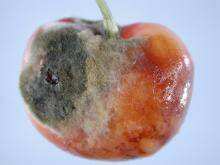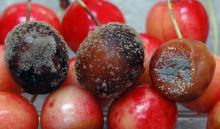See:
Pear (Pyrus spp.) - Storage Rots
Cause Many fungi. Cladosporium sp., Rhizopus rot, blue mold (Penicillium expansum), Alternaria rot, gray mold (Botrytis cinerea), and brown rot (Monilinia sp.) can occur. These rots are significantly more serious during seasons when rain-cracking occurs. Once fungal spores are deposited into these wounds, rapid fruit decay can occur. However, many of these fungi are capable of infecting healthy fruit between bloom and harvest. Infections may be quiescent only becoming apparent during fruit maturation or in storage. In Europe, plastic rain shields were found to reduce rain cracking and rots that developed before harvest.
Several of these fungal rots (such as brown rot, gray mold, Rhizopus rot, and to a lesser extent blue mold rot) can cause nesting where the fungi can spread between fruit that are in contact with one another. Alternaria rot frequently occurs on fruit doubles where the smaller tissue or spur aborts.
Symptoms Alternaria rot-a firm, brown, cone-shape mass of tissue extending toward the pit. The surface may have a lot of fluffy, white, moldy growth. The growth turns dark green to greenish black as the fungus sporulates.
Blue mold rot-circular, soft, pale brown lesions. White fungal growth with blue-green spores produced in tufts in concentric circles around the point of infection. May also have musty odor.
Brown rot-small, dark spots that enlarge rapidly. May be slightly darker than gray mold lesions when caught early and the margins fade into surrounding healthy tissue. Fruit remains fairly firm and dry relative to a watery rot caused by Rhizopus sp. Production of masses of buff-color spores is equally rapid in the necrotic area. Conidia may be produced in concentric rings around the infection site. Lesions may appear black in cold storage.
Cladosporium rot- firm, cone-shape lesions that are dry and gray to black. Velvety, olivaceous green to dark green sporulation occurs which may be easily confused with Alternaria rot.
Gray mold-soft, moist, pale brown lesion that produces a fluffy mass of gray-brown conidia. May be slightly lighter than brown rot lesions when caught early.
Rhizopus rot-soft, watery tissue and a profuse production of coarse white fungal strands with black spore heads (sporangia). Decay starts with circular brown water-soaked lesions that enlarge rapidly collapsing infected fruit.
Cultural control The key is to prevent mechanical injury to fruit during and after harvest.
- Just before the first harvest, disinfect storage rooms by fogging with ozone or peroxyacetic acid.
- Shield harvested fruit from sun and heat.
- Harvest in the morning rather than afternoon so fruit have higher firmness and less flesh extrusion risk.
- Harvest at proper maturity, and instruct harvesters on the proper technique for removing fruit from the tree. Late harvest can result in increased decay rates.
- Put cherries in clean, dry lugs or bins. Keep plant debris and dust out of bins and keep soil off the bottoms of bins.
- Hydro-cool cherries as soon as possible after harvest.
- Use a good drain belt on packing lines after wetting or coating but prior to air knives.
- Remove excess moisture from fruit on packing lines with air knives.
- Clear packing lines of culled fruit as often as possible.
Chemical control
- Preharvest applications during bloom, 10 to 14 days before harvest or after a rain that causes fruit cracking reduce postharvest losses. See Cherry-Brown Rot for materials list.
- Postharvest uses.
- Agclor 310 at 0.75 gal/1,000 gal water.
- BioSpectra 100 SC at 28 to 114 fl oz/50,000 lb fruit. O
- Captan 50 WP at 2.5 lb/100 gal water. Group M4 fungicide.
- Penbotec 400 SC at 16 fl oz/100 gal water for dip (wash) tanks. Registered for brown rot and gray mold. Group 9 fungicide.
- Scholar SC at 16 fl oz/100 gal of an appropriate carrier for inline dip or drench. Use at 16 to 32 fl oz/200,000 lb fruit for inline aqueous or fruit coating spray. Use only once postharvest. Can be used for many different stone fruits, see label for details. Do not expose treated fruit to sunlight. Group 12 fungicide.
- StorOx has received registration for use in packing houses and food processing plants as a broad spectrum bactericide/fungicide. To the best of our knowledge, its efficacy in controlling postharvest rots has not yet been tested.
- Tebucon 45 DF at 8 oz/25,000 lb fruit. Group 3 fungicide.
Biological control
- Bio-Save 10 LP (Pseudomonas syringae strain ESC-10) at 500 g/25 gal water. Suspend in water for 10 to 30 min before use and agitate periodically. Dip or drench at least 1 min. Rated as moderately effective. O
Reference Forster, H. and Adaskaveg, J. E. 2022. Postharvest Diseases of Stone Fruits. In Adaskaveg, J. E., Forster, H., and Prusky, D. B., editors. Postharvest pathology of fruit and nut crops. Principles, concepts, and management practices. St. Paul, MN: APS Press.


